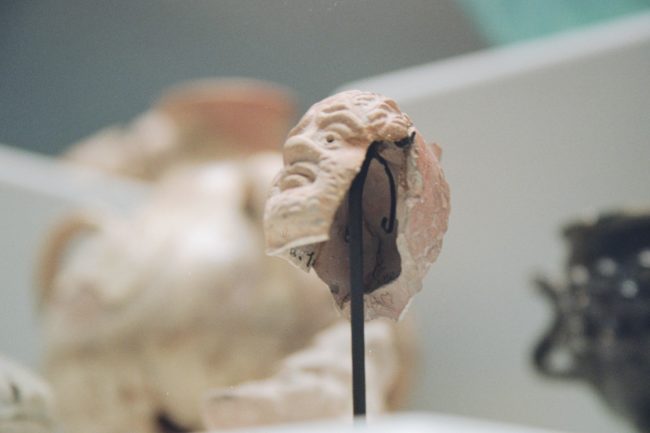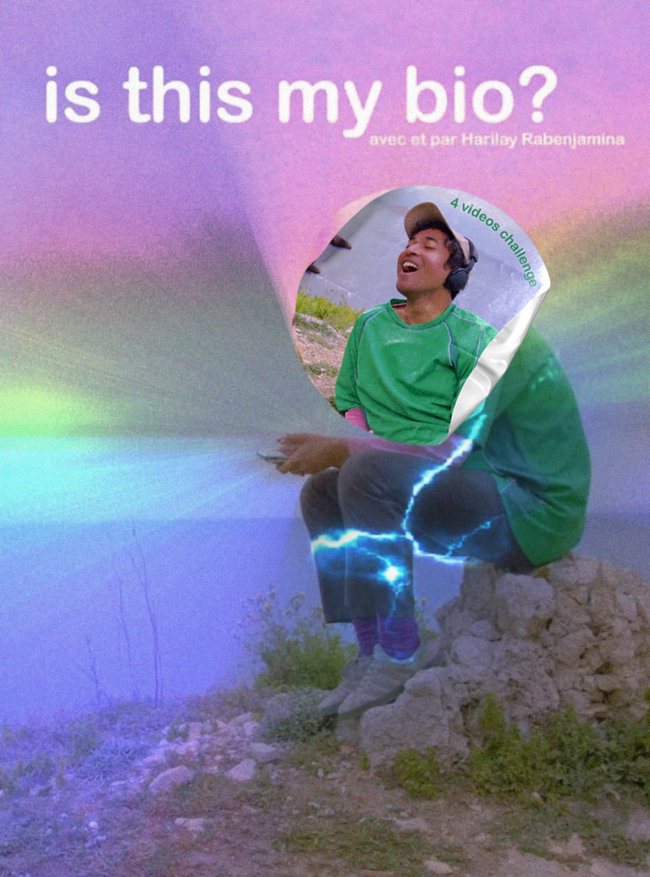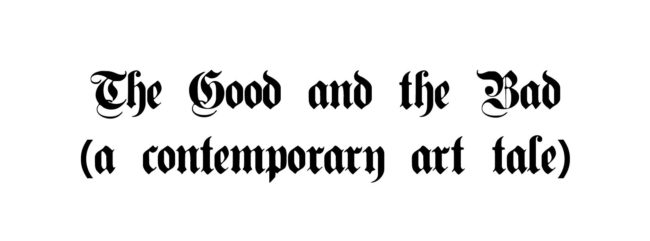Conversation with Emii Alrai
Archaeological objects and landscapes are Emii Alrai’s starting point. Often created at room scale and composed of numerous objects, her work negotiates the notions of truthfulness and falsehood, and explores the limits of a still largely colonial museography.
Drawing from her years at the University of Leeds as a Fine Arts and Museum Studies graduate, she made investigations on landscapes’ corporeality and memory through sculptural works. Yet, during her artist’s residency at the contemporary art centre Triangle – Astérides, Emii Alrai decided to put her production aside: no art installation took place in her studio. Over a period of three months, she developed a new line of research, which involves collections from Marseille History Museum as well as from other regional archaeological sites.
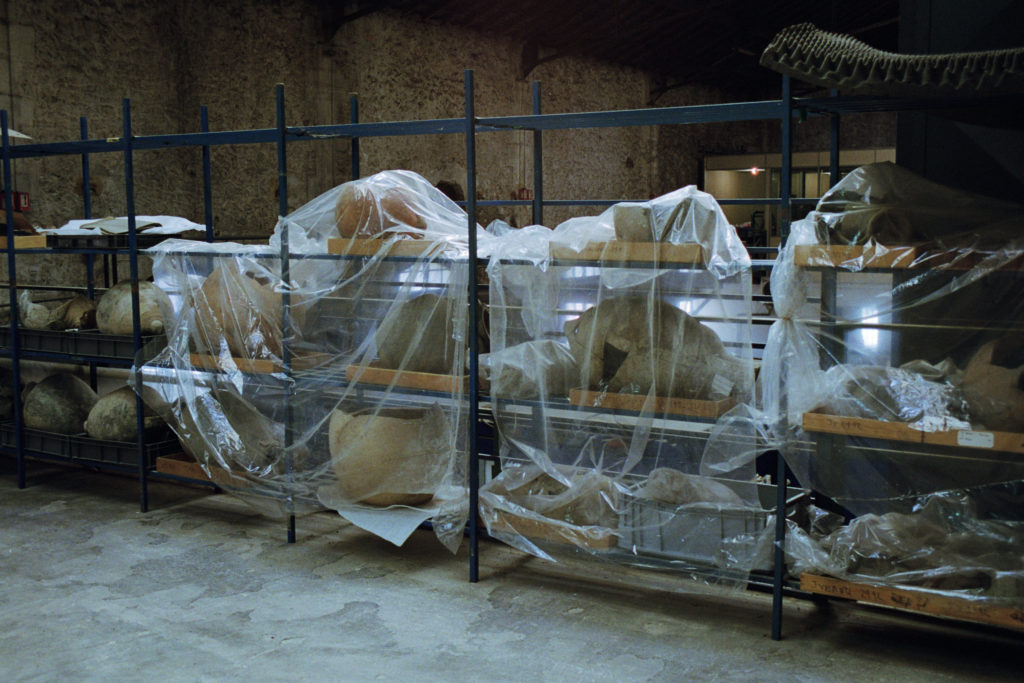
Flora Fettah Hi Emii! Today, you are introducing Capture on Bruise Magazine, a research you’ve developed in Marseille during your residency. Can you tell us more about its specificity and connection to your practice?
Emii Alrai The investigations I made in Marseille can be thought as a continuation of previous research, undertaken as part of my last exhibitions. I am interested in the materiality of objects and on the way materials can embody narratives. These considerations draw upon research underpinning my practice. For instance, I focus on the possibility of recreating identities, memories, and geographies through materials like plaster, sand and clay. I’m interested in how the particular use of these materials can actually materialise the geography of places we have never visited.
When I first arrived in Marseille, I wanted to use this time to read and carry on with my research on archaeology, landscapes and memory without having to produce any work necessarily. I had the idea of developing a project within Marseille’s museums, of visiting their spaces to see the different methods used for the hanging and display of objects. I think I really wanted to reflect on the way museums use and create a hierarchy that dramatises space. Coupled with that was a desire to understand the links that bind them to the landscapes from which these objects are extracted. In the context of a museum, little importance is given, most of the time, to their original environment.
I have been reading a lot on archaeological memory and on the importance of objects, on the reasons why they are so desirable. I also find damaged ruins interesting in that they are spread across landscapes and form an integral part of the history of archaeology and excavations. I believe this is how the project started, by trying to improve my understanding of the way these landscapes were built and stories were born.
FF Your starting point was Marseille History Museum. Why is this location relevant to your work? What did you find there?
EA First of all, it was incredible to have privileged access to the museum. Everything was closed and I was allowed to be there, alone, and spend time with all these objects. I wanted to learn about the history of Marseille, which is of great interest from the perspective of its cultural diversity: it witnessed a constant ebb and flow, and its gorgeous landscapes are steeped in narratives. A whole mythology has been created around them and their surrounding rocks and sea.
A large part of the works I created has begun with collections from museums. These locations are so interesting and provide food for thought, partly because we tend to project our own stories onto the objects that inhabit them. It is so inspiring to walk through these museums, contemplate what is there and how these works are presented: each one of them has its own way of exhibiting and interpreting them.
When I started documenting the collection of the Marseille History Museum, one of the things that struck me the most was the armatures that are used to hold and display the objects. In western museums, it’s almost like a trend: we see them a lot, but they are meant to be hidden, placed at the bottom where no one can see them. The basing system of MHM is particularly intricate: it could almost be considered an artwork in itself. I began taking many 35mm photos through which I would zoom-in on the metal and armatures, rather than on the objects themselves. It was quite fascinating to see the way these metallic forms were shaped to fit a certain type of object and were made almost invisible to the viewer. It creates a very odd dynamic between the armature and the object it is gripping. This is why I took a real interest in these armatures, and the purpose of my photography was to highlight them.
I was also lucky to have been given access to use the museum's library and talk with the director and curators; I discovered and explored the archaeological sites of Marseille and got in touch with the archaeological depot of Marseille. All my research was structured around the stories brought by objects, from the excavation site to the museum where they are exhibited, including their study and classification.
"In the museum, we see vestiges held, taut and captive, in a process which removes them from their further deterioration. We witness them in the split between living and dying, between their absence and presence. They are understood as places which hold memory. They are preserved in the moment in which they were beginning the process of disappearing."
FF What you say evokes issues related to the sacralisation of objects: sometimes these are considered ordinary, other times sacred. They also belong to a society which gave rise to museums, and if they come from a different civilisation, these are shown, (re)sacralised and become works of art. This process, in my opinion, is also a form of capturing.
EA Absolutely. When you think about it, you realise how crazy this system is. It is telling that these collections began as cabinets of curiosity, composed of trophy objects. This is tightly linked to the romanticisation of the past, to the way history is taught to us, and to the value we give to these ancient objects. How do we measure the value assigned to them? Is it because they are fundamentally important? Is it their beauty? Is it because, through them, we are able to see the trace of the last person who manipulated them? Or is it because we like collecting things and ascribing meaning to them? It’s quite easy to sacralise objects since most of the time we consider that there is some special beauty in them, and we feel that they “reveal” something about the ancient world, almost as if by magic. Ultimately, it shows humanity’s madness: sacred and ordinary objects are treasured indiscriminately, including those we used to get rid of. Everything is “remembered” inside and by museums. And what also interests me is to know why they are the only ones to be sacralised while landscapes, from which they have been extracted, are physical and historical constructions that do not hold the same status or value.
FF However, cities and their buildings are also sacralised, especially in Europe: they are listed as part of the world heritage and they have to be preserved exactly as they are, even if they are no longer adapted to the needs of the people inhabiting them. In a way, we live in some sort of open-air museum. And this is very representative of the west. It’s quite interesting to see how conservation and restoration are presented as the way forward, without any second thought. It is linked to History, and more specifically to a certain idea of what History is supposed to be, without really taking into account its links to mythology and the political role of these symbols.
EA And when you find yourself in these types of places, you almost feel oppressed by this museumification process. I don’t have the right answers but one can’t help but wonder why some spaces, where constructions had a particular function, cannot be used any longer, and whether there are other possible uses. People are so scared of seeing these places being demolished that all that is left is distant contemplation. They are losing the energy that they could acquire through the unfolding of our contemporary History. I think it is crucial to be able to touch these architectural objects, to have a physical contact with the landscapes.
The interaction between these historical spaces and newer cities is fascinating: what is the relationship between them? Who makes decisions on their aesthetic aspects? How will these buildings age and become part of our History? How can a dialogue between materials be established? How do we integrate “non historical” materials, and how do we allow History to develop in these types of locations despite their extremely rapid construction? How should we talk about the future, how can we preserve it, and how do we turn the future into a museum?
FF Everything you just said is strongly connected to the creation of myths and mythologies, to the way objects can carry these stories. Correct me if I’m wrong but it looks like this topic keeps you busy, especially in relation to the Middle East?
EA Very much so. Before I arrived in Marseille, I really centred my work on the Middle East and on the way images and materials were at the root of fantasised perceptions: they are linked to the way the region is portrayed, especially in television programs that often make use of war-torn landscapes, which we imagine very dry, sandy and dusty.
My interrogations always revolve around these issues: as part of the diaspora, I create new traditions and mythologies through my own past and the cultural influences I had growing up. However, I am also aware that these cultures don’t really exist since they are contained within this community and do not really apply to those of my homeland. When we leave room for imagination, mythologies allow us to play with reality and make associations without them being grounded in something literal. And in relation to the spaces we talked about, we can say that they are founded by myths: are these places important due to the particular material they are made of, to their beauty, or to the fact that we were told that they were important? Myths protect these locations and make them part of our History; and people can become extremely emotional over what they identify as being part of their cultural history. In this regard, the case of the destruction of Palmyra is truly significant: western media portrayed it as the worst thing that could ever happen, despite the fact that a civil war has been going on for several years. This is probably because the destruction of objects involves the destruction of the myth. This raises the question of the importance we assign to them at the expense of the political issues at stake and of the sense of ownership people have towards these sites and objects.
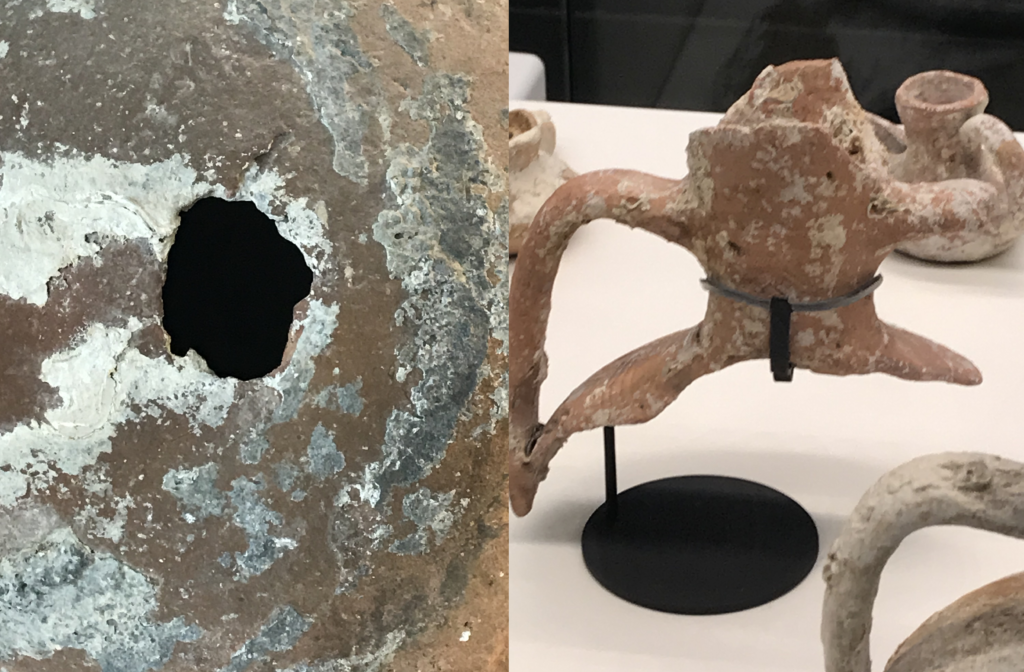
FF We realise that, more often than not, notions of universal or cultural heritage refer to a sense of ownership imposed by the west on heritage originating from non-western countries. It also justifies some practices: its collection and preservation inside western European or North American museums. The line of defence, which I believe is not valid since it was dismantled by Felwin Sarr and Bénédicte Savoy’s report, argues that we all share the same cultural heritage and that these museums are the most suited to properly preserve it.
You actually mention this in your film, when you show that museums are places of violence in that they hold many objects captive, both through cultural policies and basing systems:
"These armatures are made from metal, which has connotations of violence in its materiality. Metal, linked to weaponry, and hunt, is the main complex system employed by museums in their final showcase of the objects. The objects become hunted, captured, held in position through this fabricated weaponry, which from a conservation perspective, is also a cause of ruination of the object itself."
EA I really wanted to explore the way museums are places of violence and aren’t that different from galleries dedicated to hunting or trophy rooms. We were taught that the latter were places showcasing brutality but, actually, museums carry the same violence: they are spaces where we find objects that have been looted, robbed and that saw people die on their way to Europe. And today these same museums use their status as cultural institutions to avoid talking about their colonial history: that of grave robbery and archaeological excavations. They sent people to foreign countries to take control of objects in order to exhibit them later: when you think about it, it’s completely crazy.
And then, in the museum itself, we realise that the basing system is made of the same material as the one used for weapons: metal. Metal is both a magnificent and violent material. It is used for swords, rifles and all sorts of guns. It is used to hold and grip the objects and fragments on display – these already damaged things. What does it do to them? Do objects die in these types of contexts, in these museums to which they have no connection? One of the curators of Marseille History Museum told me that she hated these armature systems as they actually damage the objects as they hold them. It then becomes extremely difficult to extract them from it without damaging them in the event of restoring processes or research. The reason behind this choice of armature is wild and fascinating: both armature and weapon, it has a particular aesthetic that is more suited to dramatize the glass displays in which objects are placed. It creates a setting that is as delightful as it is abject, violent and colonial. What is at play is so dense; there are so many layers of histories, stacked on top of each other, that do not even communicate with the object itself.
FF Now you have returned to Leeds, where you currently live. Capture seems to be halfway between a presentation and an artwork. Is it due to the fact that you’re not done with your research? Will you continue this work?
EA This project really is an experiment since it is the first time that my work is centred on photography. It also allowed me to work with archival material and create a collection made of images. Compared to my sculptures, this may be a more direct and explicit way of talking about my research. I actually see it as the beginning of an exploration: this work contains so many different themes that have been present since the early days of my practice, and that can be even more developed in the future.
I am still thinking about it, but there is a possibility for me to continue taking photos of armatures belonging to other museums in order to create an archive. Books explaining how to create an exhibition always talk about curating and preserving objects, about lighting adjustments, but never about the system that holds them into place, about the materials used to secure them without destroying them.
I was also very impressed by the archaeological depot, which taught me about of the way archaeologists work, and which has nothing to do with the practices used by museums: they grab the objects, they manipulate them, and when these join a collection, the opposite happens. I worked with collections in Leeds and all is carefully regulated and systematised. By contrast, in the deposit, people are not afraid of touching objects. I personally think this is also a way of entering in contact with them, with the ghosts and stories that follow them. So it’s an institution that is always reflecting on and learning about the way a society builds itself. I believe I learned much more from the objects that were in archaeological deposits than in museums.
The photos I took there are, in my opinion, specific to Marseille, to its collections and deposits. I would therefore like to see how things happen in other museums, have conversations with other archaeologists, in order to know whether the process is similar elsewhere, and if it needs changing.
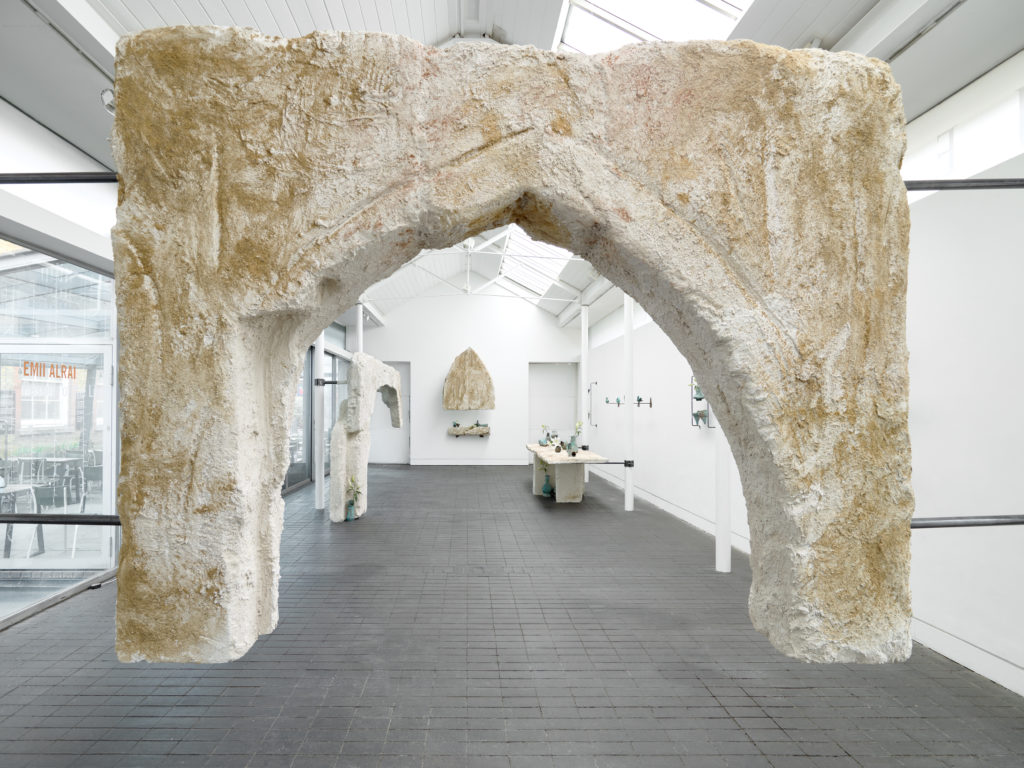
FF Finally, this residency was a time for experimentation in terms of media, techniques and even research. How do you connect it with your previous works? What impact did it have on your practice?
EA All my work starts with the same thought. But these past few years have been very much driven by production as far as I am concerned; to the point that it was sometimes difficult to create links between artworks. Dedicating time to research and experimentation allowed me to understand all the layers that my work implicates and to distinguish new exploration avenues. When I arrived in Marseille I was exhausted, especially given the Covid/Brexit context, which made it all the more complicated. I had just created four enormous sculptures for a commission at Jerwood Arts. In art schools, we learn to become ultra productive and to always provide a “finished product”, which made it difficult to accept that I was not going to create anything physical, that I was not going to be in a studio every single day, but in museums or libraries instead. I feel after this time, this space needs to become more prevalent for my future practice and it is an integral part of making work. Although it wasn’t easy to accept that the studio was empty and that there wasn’t much to show when people visited me. While I apologised profusely for it, I now realise that I shouldn’t be sorry for not creating monumental works. At that point, working with materials was no longer enough; I had to think about the methodology that sustains my artistic process. I don’t know what would have happened if I had not taken these moments to breathe, to allow myself to read, to look at images, to think, without having to produce anything. These are moments I want to continue having in the future.
French-to-English translation: Zahra Tavassoli Zea
You can discover Capture, the work conceived by Emii Alrai during her residency, on Bruise Magazine.
Capture is supported by Fluxus Art Projects.






































